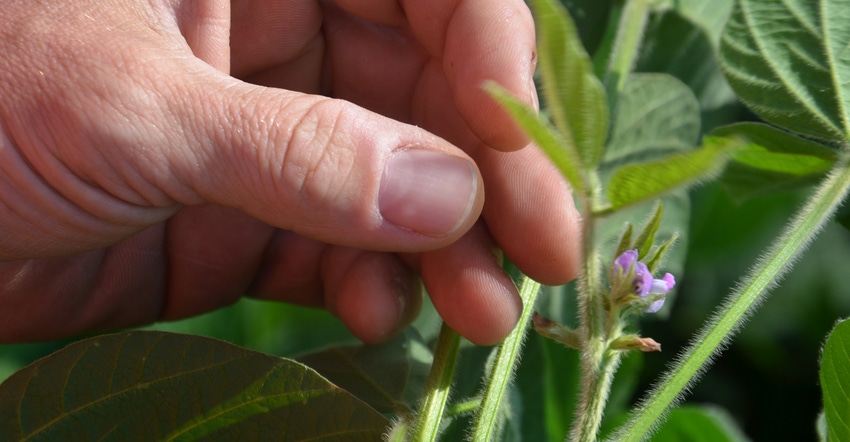
There are two questions to answer soon about this year’s soybeans. Are you going to spray fungicides? If so, when?
Steve Gauck walked the Soybean Watch ’19 field within the last few days. For the most part, he found minimal disease. He saw a frogeye leaf spot lesion here and there, sometimes only one or two on a leaf. He found some downy mildew, particularly in one of the two varieties in the field. However, the Purdue Corn and Soybean Field Guide reports that downy mildew seldom causes economic loss in soybeans. Otherwise, the field was close to being both disease- and insect-free.
“We had lots of Japanese beetles three weeks ago, but they haven’t found this field,” Gauck says. Except for a few random holes here and there, he saw very little insect damage. He didn’t find any green stinkbugs in the field. The field was planted June 12 and is in the reproductive stage.
“The main reason to spray a fungicide in this field would be if you thought you could pick up health benefits that would help plants through stress,” Gauck says. He is a sales agronomist for Beck’s, based near Greensburg, Ind. Beck’s sponsors Soybean Watch ’19.
While picking up supposed health benefits from fungicides is the most debated claim for these products, Gauck says if you think it’s valid, this might be the time to do it. With little rain in the forecast, soybeans could face dry weather stress during the critical reproductive phase.
Timing
If you are going to spray, R3 is the recommended time. Many university experts recommend it, and it has proved out in Beck’s Practical Farm Research plots.
“The theory is that the most productive nodes to produce pods and beans are in the middle part of the plant,” Gauck says. “You want to protect them so there is maximum area to capture sunlight. If you apply at R3, when pods are forming, fungicide can still cover and penetrate leaves that are tied to those middle nodes. Fungicides are not systemic, so you need coverage on leaves.”
Why not wait until later? “It becomes harder to get coverage down to lower leaves still associated with the lower most-important nodes,” he explains. “And if there was disease, damage might already be done.”
One variety of the two planted in the field was in full R3, with pods about one-quarter inch long at one of the four uppermost nodes. Actually, they were forming at all of the four upper nodes.
The other variety, due to genetics, was about five days behind, just entering R3. It was still flowering, with pods of that size just starting to form.
“If you were going to apply fungicide in this field, you would want to do it soon,” Gauck concludes. “There were spray tracks already in the field, so you could apply with a high-clearance sprayer. Or it could be aerially applied.”
Applying with a high-clearance sprayer would make it easier to leave untreated check strips so you could determine if spraying paid for itself this year.
About the Author(s)
You May Also Like




